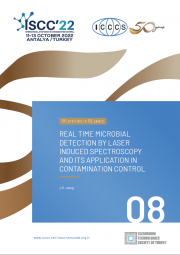REAL TIME MICROBIAL DETECTION BY LASER INDUCED SPECTROSCOPY AND ITS APPLICATION IN CONTAMINATION CONTROL
Authors:
J.P.JiangKeywords:
real time microbial detection, environmental monitoring, trend analysisAbstract:
A technology based on optical spectroscopy has been developed for real time detection of environmental microbes and continuous monitoring of the environment. This technology utilizesMie scattering for airborne particle size measurement in the range of bacterial matters, and the detection of intrinsic UV-induced fluorescence from certain bio-chemicals inside bacterial cells
as a biological marker. The optical instrumentation techniques used to achieve the requisite detection sensitivity and the procedure for its validation test will be presented.
One necessary aspect for applying this technology in contamination control is how to correlate its results to compendial microbiological methods and how to set the new limits based on this new
method. A statistical process control (SPC) approach to the environmental monitoring of bioburden in parenteral aseptic facility is proposed to achieve this goal. This presentation will
cover (1) the procedure of setting new limits using a new instrument, (2) the control chart methodology of utilizing environmental monitoring data to assess the state of control in a
parenteral production environment and to troubleshoot the root cause when a variation from normal trend is detected.
Some application examples will be used to illustrate how to utilize the real time microbial detection features of this technology in the environmental monitoring and contamination control.
Topics of discussion include sensor placement, data analysis, graphic data display, and trend analysis.
Article:
1. Introduction
The compedial method for environmental monitoring in pharmaceutical manufacturing environments is growth media method. These methods require a number of days to elapse while
samples, collected intermittently, are incubated. Advances in optical technology now promise both an instantaneous and continuous means for detecting airborne microbes.
In recent years, several of such rapid microbial methods have been developed for pharmaceutical contamination control applications. The examples of these real time optical microbial detectors
are BioVigilant System’s IMD™-A detector, Particle Measuring Systems’ BioLaz and TSI’s BioTrak. A typical optically based microbial detector instrument can instantaneously and
continuously detect a particle’s size and the laser induced auto-fluorescence from metabolite chemical compounds inside microbes (e.g. NADH, riboflavin and dipicolinic acid) as biological
marker to differentiate microbes from inert dusts. As an example, the optical schematic of BioVigilant’s IMD-A is shown in Fig. 1 below. The detection of microbes by IMD-A is done in
real time as the target particles flow through the instrument.

 Click to Download PDF
Click to Download PDF
